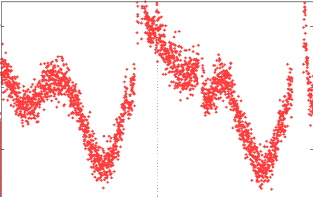Interferometry relies on the change in the phase of two orthogonal light beams reflected back to the source point. Assume there is an interferometer at the equator, one mirror is planted 1 mile due north and another mirror is planted 1 mile due east. Every 6 hours the axis of the east mirror-interferometer experiences a tidal effect and its length should increase. Michaelson and Morley would not have detected this because their mirrors were planted on the same piece of granite which could not expand and contract. But the mirrors in the LIGO interferometer should detect this. Do they?
2 Answers
This exact question was considered in a 1997 LIGO paper by Raab and Fine entitled "The Effect of Earth Tides on LIGO Interferometers". Not only is there the expected semi-diurnal tide (known as the "sectorial" component of the tide) but there is a diurnal ("tesseral") component due to the Sun and Moon not being in the equatorial plane of the Earth.
The resulting length changes in the LIGO arms are very significant compared to the magnitudes of the sought-for gravitational wave events. The biggest tidal amplitudes produce changes on the order of 100 microns.
The effect was then measured in 2006-2007 and reported by Melissinos in "The Effect of the Tides on the LIGO Interferometers". This extract of a two-day period in the observing run clearly shows the diurnal and semi-diurnal components:
In the LIGO interferometers, there are various sources of noise. As the saying goes, "one person's source of noise is another person's signal!" So there are geophysicists who study seismic and atmospheric waves and there's whole fields of study on these things that are very interesting and rich. Gravitational wave detectors treat those signals as a type of noise, since they're interested in pulling out a gravitational wave signal that originates extra-terrestrially.
That said, there are numerous sources of noise among the vibrations that LIGO detects. Indeed, the only reason LIGO has detected gravitational waves is due to the immense engineering/analysis efforts accomplished over the last 50 years. Here is a complete guide to LIGO noise cancellation and signal extraction.
Now to answer your question: the LIGO interferometers are certainly sensitive to seismic waves of all sorts, the image below of theoretical noise curves in the LIGO detector shows lots of sources of noise and you can clearly see the seismic wall (brown curve) at $\sim 10$ Hz (and the advantage of space-based observatories is that they do not have this wall of noise!). LIGO is also sensitive to changes in the tidal field of the Earth due to the propagation of the seismic waves themselves, this is called "Newtonian Noise" or "gravity gradients," which is the green curve in the figure. All these sources of noise are accounted for in data analysis, and future engineering goal is to have real-time feedback systems so the seismic and Newtonian noises can be cancelled out of the data in real-time.
[Image credit]
A experimental noise spectrum for the LIGO detector looks more like this:
 . [Image credit]
. [Image credit]
Lastly, the Michelson-Morley experiment was too small to be able to be sensitive to the gravity gradients. LIGO detector arms are $\sim 4$km long, while the Michelson-Morley apparatus was $\sim 10$m. Modern Michelson-Morley type experiments have pushed the sensitivity to levels comparable to LIGO, e.g. here and here, however, due to advances in quantum optics and other things.
-
$\begingroup$ Thank you for showing me the complexity into which my question waded. I noticed that you interpreted my question as asking about noise. Certainly vibrations in the mirrors would cause strain noise.And the scale is measured in hertz. But I am thinking about the meters that the earth stretches due to the gravity of the sun and the moon. The equatorial axis of the interferometer should stretch much more than the axis pointing north. I am not asking about changes in the earth's gravity either. I simply asking about the changing distance of the mirrors that happens every 6 hours. $\endgroup$ Commented Dec 14, 2020 at 2:00
-
$\begingroup$ Oh. WELL, what makes you think the effect of moon's gravity on Earth is on the order of "meters"?? It is miniscule, far smaller than the curves shown above, since the Earth-moon system is ~20 million time less massive than a binary black hole. The moon's gravity is strong enough to effect the tides. The bulge of the Earth at its equator is due to the Earth's rotation, not due to gravity. $\endgroup$ Commented Dec 14, 2020 at 12:06
-
$\begingroup$ More importantly, the frequency of the Earth-Moon system is far too low for LIGO to detect, i.e. it's below the seismic wall I discussed above. "the Moon’s orbital period is 27 days; the period of the gravitational waves generated by its orbital motion around the Earth is 13.5 days. LIGO is only sensitive to gravitational waves with periods between about 0.02 seconds and 0.001 seconds. The gravitational waves from the Earth-Moon system would be well outside the range of periods LIGO can detect." astronomy.com/magazine/ask-astro/2016/06/gravitational-waves $\endgroup$ Commented Dec 14, 2020 at 12:07
-
$\begingroup$ And see this physics.stackexchange.com/questions/412980/… $\endgroup$ Commented Dec 14, 2020 at 12:08
-
$\begingroup$ it's not just earth -moon, it's earth sun. the tides on our planet are due to earth sun moon tidal effects. even millimeters of stretching add a million times of variation to the distance of the mirror and the source of in the LIGO interferometer that it can resolve. I was hoping for someone who actually worked at LIGO to address how this variation is normalized. Certainly, if a measurement occurs on the order of microseconds, then a calibration followed by measurement could eliminate most of it. $\endgroup$ Commented Dec 14, 2020 at 16:47

